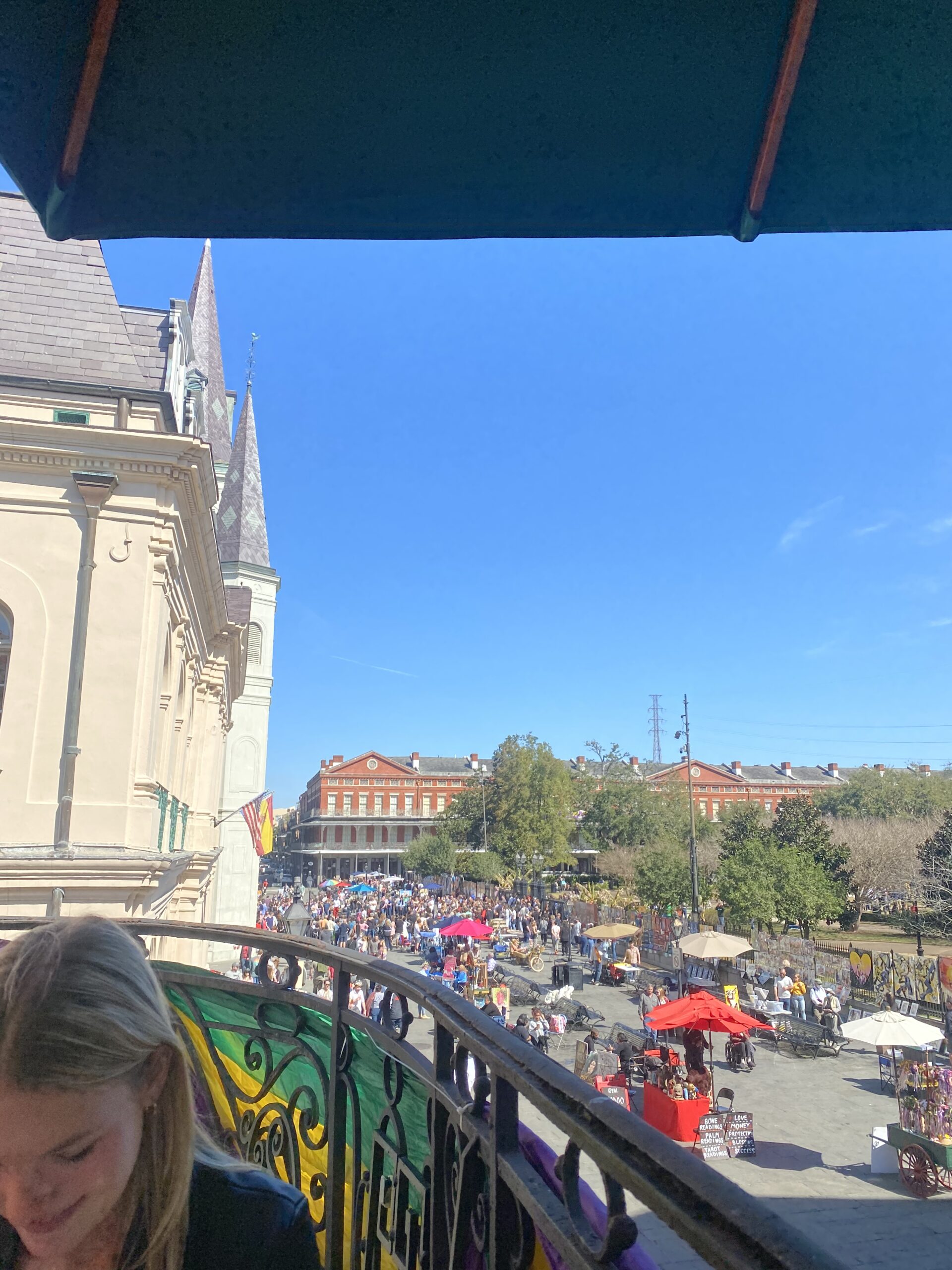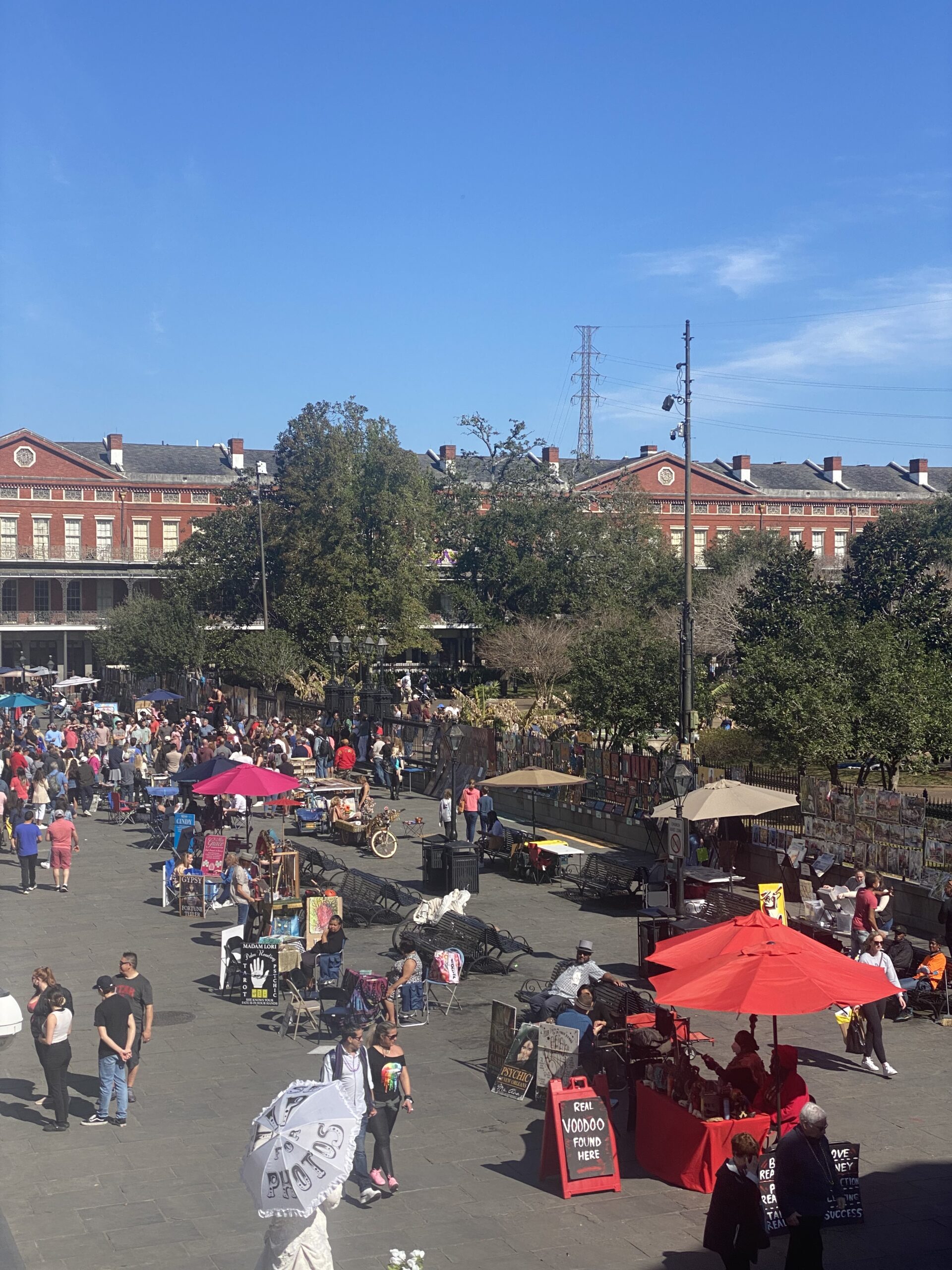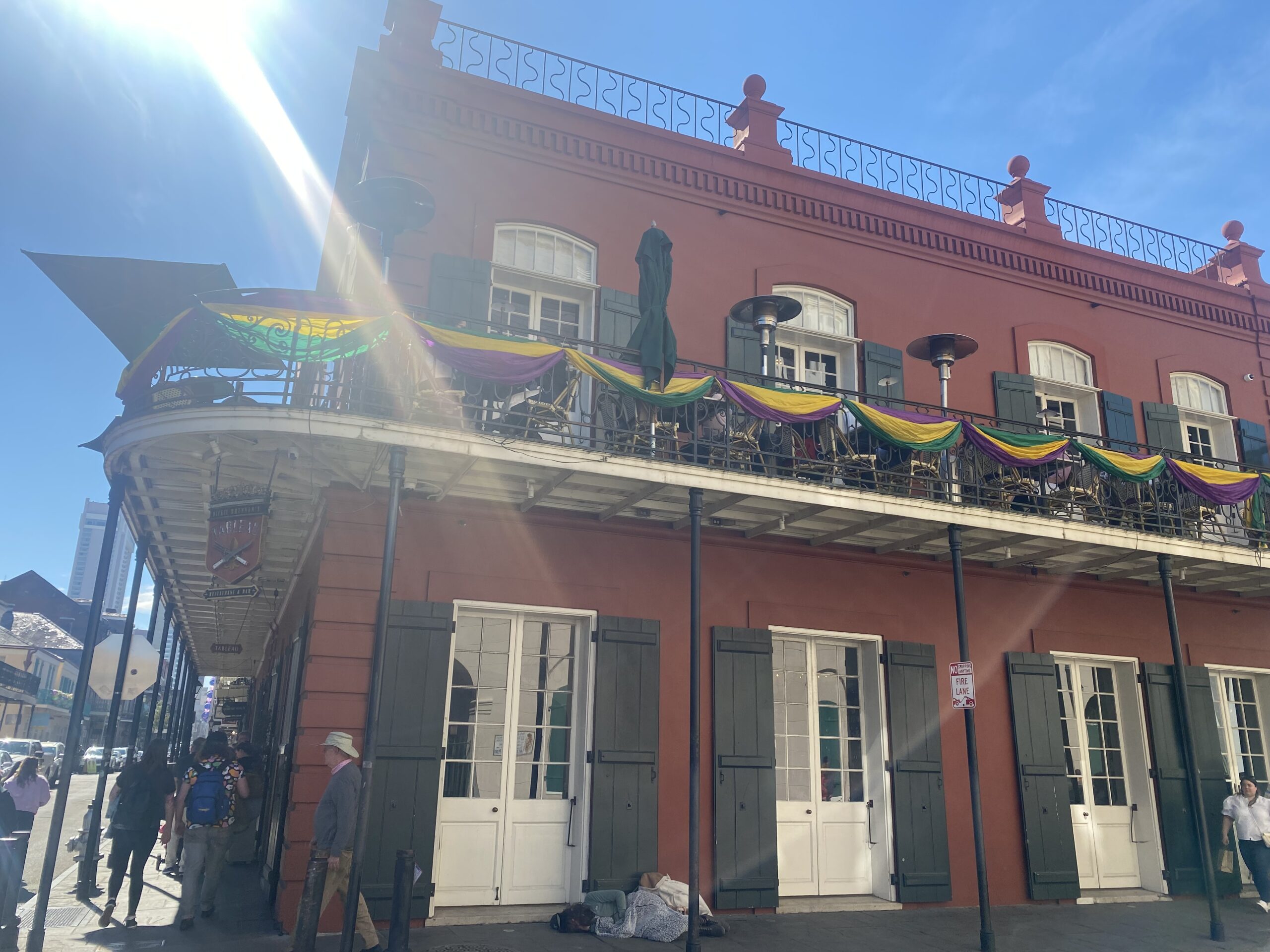Curious tourists and reservation-savvy patrons alike wander into Tableau Restaurant for Saturday morning brunch. The tie-clipped waiters hint at the change in tone from outside, where constant commotion engulfs the corner of St. Peter and Chartres St. Beyond the front desk lies the first seating option, the courtyard, draped in ivy and surrounding an inoffensively flowing fountain. Inside, flickering chandeliers line the napkin ringed tables. Polite, jubilant conversation flows. Mellow enough for intimate table conversation, guests can gather for special occasions here. While faint commotion trickles

View from the Tableau balcony
in, most of the outside world remains tucked away. Walking past these areas, the host leads his patrons to the spiraling staircase at the other end of the dining room. Praise for Tableau has been printed out and framed, and now lines the staircase. Upon arrival upstairs, patrons walk out to marble tables that rest against the old iron balcony. The menu resembles a leather bound notebook, and every page contains about five items. Three are pronounceable. At every table, in every seating area, baseball caps and sport coats are welcome. Upon sitting down, the ambiance and table, and occasionally the table conversation, tend to fade behind the captivating Jackson Square that bustles below the balcony.
The name Tableau originates from the French language, referring to a memorable image or scene. Tableau shares an entryway with Le Petit Theatre, where amateur thespians have gathered since 1916 to perform. These tropes of performance and watching become far more evident upon looking out beyond the iron railing, where hundreds of people wandering Jackson Square resemble Dodwell’s Bazaar of Athens. The outward facing seats encourage glancing at the scene. Within the confines of the balcony, one could passively survey strangers, inserting narratives and asking questions about someone they will likely never see again. Professor Irena Praitis differentiates such viewing from voyeurism, stating while voyeurism involves watching another to have power over that person for one’s own pleasure, surveillance involves watching over another and having the power to determine, judge, and report on their crimes, failures, or adverse behavior. Surveying appeases intrinsic curiosities, while answering abstract questions about others. Much can be said about body language, as scientist David Fouhey claims that the human body is a powerful and versatile visual communication device. When surveying the public, a bystander’s disposition and facial expression tells an intriguing story. In Jackson Square, such a bystander watches as a busker hovers five feet above the air, perplexing the large crowd he gathered by escaping a straitjacket with ease. The ordinary and the outlandish stand next to each other throughout the square.
Originally named the Place d’Armes, Jackson Square sits in a prominent position between the French Quarter and the Mississippi River. Where soldiers used to congregate for drill procedures and inspections, a human statue now stands, with her skin painted gold as she wears an antique

The walkway of Jackson Square
wedding dress, waiting for people to approach and take photos with her. The Tableau Balcony, perched across the street from the Cabildo Museum, offers a view beginning with the high arches of St. Louis Cathedral, and spanning across the square to Cafe du Monde. In the span of a two hour meal, characters of Jackson Square continue to entertain, as the scene continually develops with new crowds.
Furthest from the balcony lies the 200 artists permitted to sell their work on Jackson Square. Very few parts of the square’s iron gates remain visible, as artists utilize the space to display their work. The largest continuous display of art in the United States began here 100 years ago. Scenes of the French Quarter and Second Lines repeat in varying mediums, alternating background colors of gold, purple, and green. Most artists here produce art for people who want a souvenir or memento of their stay, causing gallery artists to claim artistic supremacy over those in Jackson Square. Some fire back at criticism, arguing against the square as a place which fosters the development of art, but instead merely a place to sell art. Quality of entertainment holds a greater significance in this space than legitimacy, where artists find success in the fullness of their tip jars. Perpetuating the surveillance in the square, many artists actively paint images, simultaneously selling their existing pieces. Caricature artists mesmerize tourists with artistic commentary on human appearances.
While Tableau patrons watch many things happening at once, trumpet music overpowers any other noise in this section of the square, capturing attention. Musicians stagger themselves among the crowd, perhaps benefitting the most among performers from the surveillance. A man blows his trumpet, pacing in circles under the St. Louis Cathedral entrance. Where a culture of amateurism may appear among artists in the square, some musicians seek legitimate opportunity, finding a starting point to launch their careers. Jazz music has filled Jackson Square and the French Quarter since the late 19th century. Jazz is America’s classical music, as both a way of spontaneously composing music and a repertoire, making it an appropriate addition to both the street and an upscale dining experience.
The theatrical essence of New Orleans transcends the performers, permeating even into the tourist culture. The most fleeting of the characters to cross Jackson Square, the onlookers present variations of Mardi Gras colors and costumes through their appearances. Tourists spend upwards of $9.5 billion in New Orleans annually, creating a vital industry for the city. Visiting such a significant destination constitutes dressing for it. Bachelorette parties, color coordinated and leaving traces of sparkles where they walk, and birthday revelers, proudly sporting dollar bills on their chests, call attention as they wander the streets. The celebratory environment encompasses everyone, as non-performing people in Jackson Square still contribute to the fascinating scene.

View from outside Tableau Restaurant
As the bill comes around at Tableau, the enticing view subsides to the background, and the daze of people watching halts. Patrons who watched Jackson Square during their meal walk back onto the corner of St. Peter and Chartres, where commotion remains. After spending time watching the square from an aerial view, a new order appears among the chaotic mob. The artists stand far away, somewhat removed from the crowd, so their images can rest against the fence. The musicians play on the outskirts of the square, so as to not play over one another. The stunt performer stands in front of St. Louis Cathedral, where he can rally the largest crowd. The woman, painted gold and wearing a vintage wedding dress, has yet to leave her podium. The onlookers watch for 5 minutes, then move on to look at something else. Every sunny Saturday, these people are here. The Tableau waiter sets down new place settings, preparing for the next round of watchers to sit down.
 NOLAbeings
Multimedia artist Claire Bangser created NOLAbeings as a portrait-based story project that marries...
NOLAbeings
Multimedia artist Claire Bangser created NOLAbeings as a portrait-based story project that marries...
 Data corner: Adobe Suite (create a PDF, social media graphic, presentation, edit a photo and video
Data corner is where you go to work with analytics and top tech skills. It takes on everything from PERL and SQL to Canva and Sprout Social.
Data corner: Adobe Suite (create a PDF, social media graphic, presentation, edit a photo and video
Data corner is where you go to work with analytics and top tech skills. It takes on everything from PERL and SQL to Canva and Sprout Social.
